1993 CHEVROLET CORVETTE brakes
[x] Cancel search: brakesPage 70 of 370
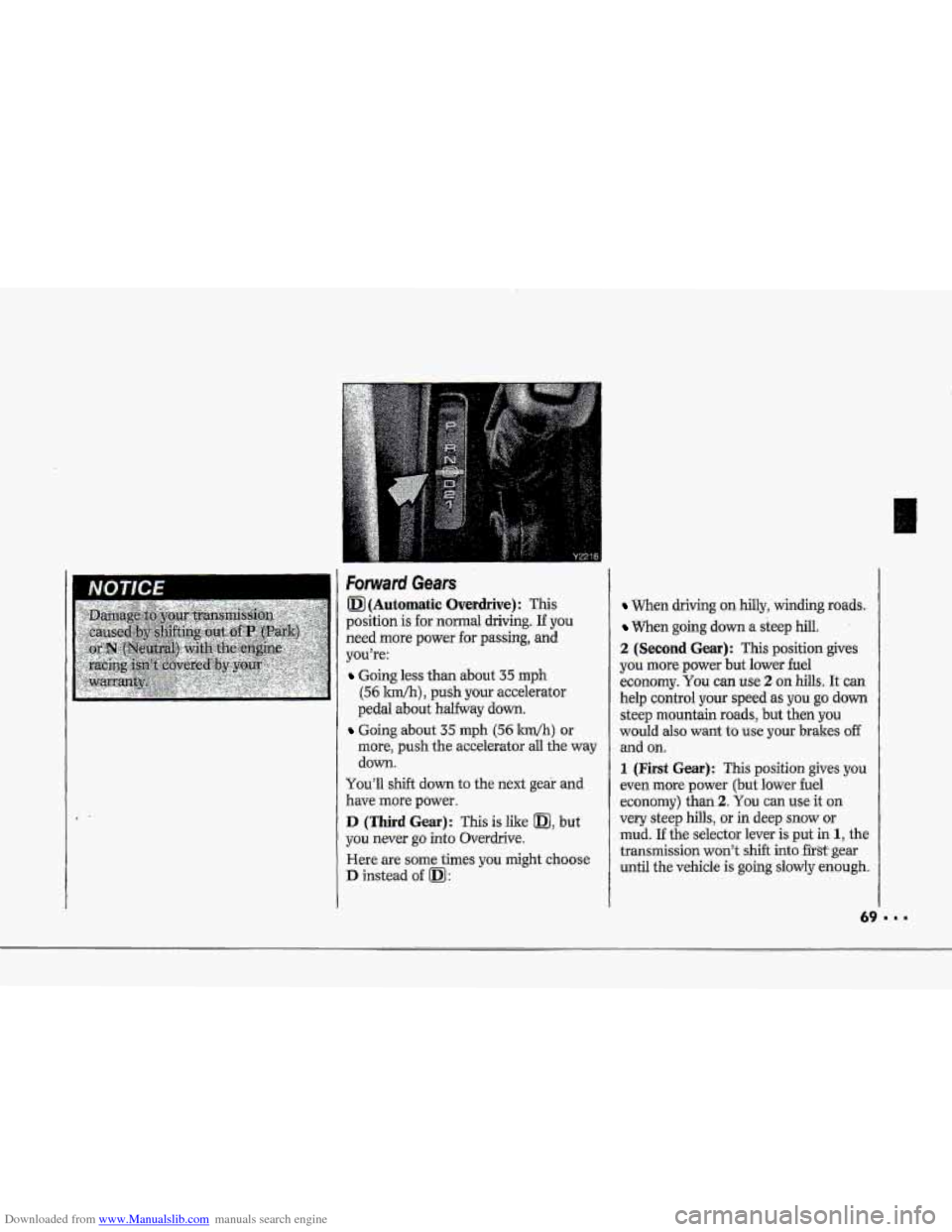
Downloaded from www.Manualslib.com manuals search engine Forward Gears I
0 (Automatic Overdrive): This
position is. for normal driving. If you
need more power for passing, and
you're:
Going less than about 35 mph
(56,lUn/h), push your accelerator
pedal
about halfway down.
Going about 35 mph (56 ldh) or
more, push the accelerator all .the way
down.
You'll shift down to the next geai and
have more power.
D (Third Gear): This is like m, but
you never go into Overdrive.
Here-are
some times you might choose
D instead of a:
When driving on hilly, winding roads.
When going down a steep hill.
2 (Second Gear): This position gives
you more. power but lower -fuel
economy.
You can use 2 on hills. It can
help control your speed as yuu go down
steep mountain roads, but then you
would also want to use your brakes off
and on..
1 (First Gear): This position gives you
even more power (but lower fuel
economy)
than 2. You can use it on
very steep hills, 01 in deep snow or
mud. If
the selector lever is put in 1, the
transmission won't shift into first- gear
until the vehicle is going slowly enough.
Page 85 of 370
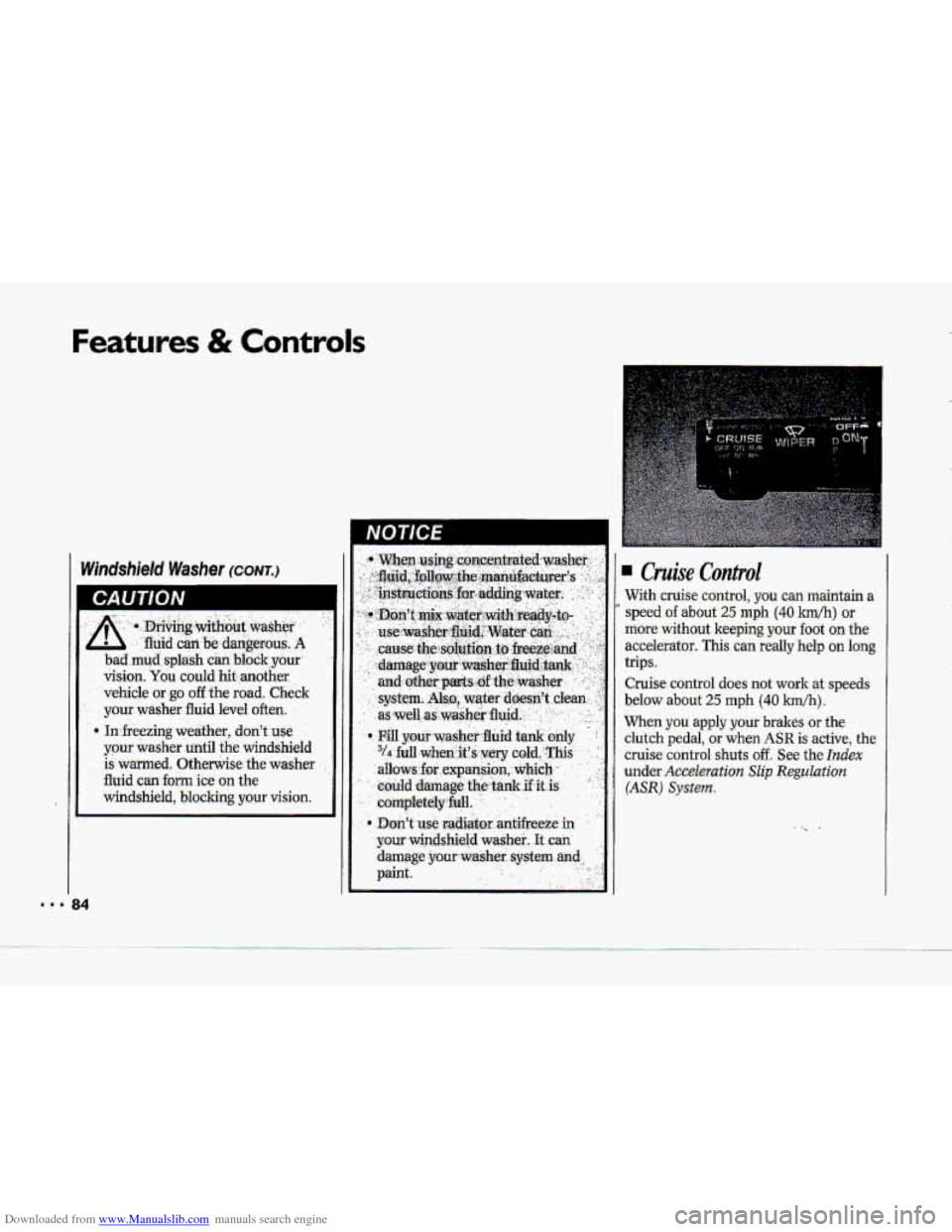
Downloaded from www.Manualslib.com manuals search engine Features & Controls
r
34
I NOTICE
With cruise control, you can maintain a
speed of about 25 mph (40 km/h) or
more without keeping your fo-ot 0.n the
accelerator. This can really help on long-
trips.
Cruise control does not work at speeds
below about 25 mph (40 Wh).
When you apply your brakes or the
clutkh pedal,
or when ASR is active, the
cruise-control shut.s off. -See the Index
under Accelerution Slip Regulation
{ASR) System.
Page 118 of 370
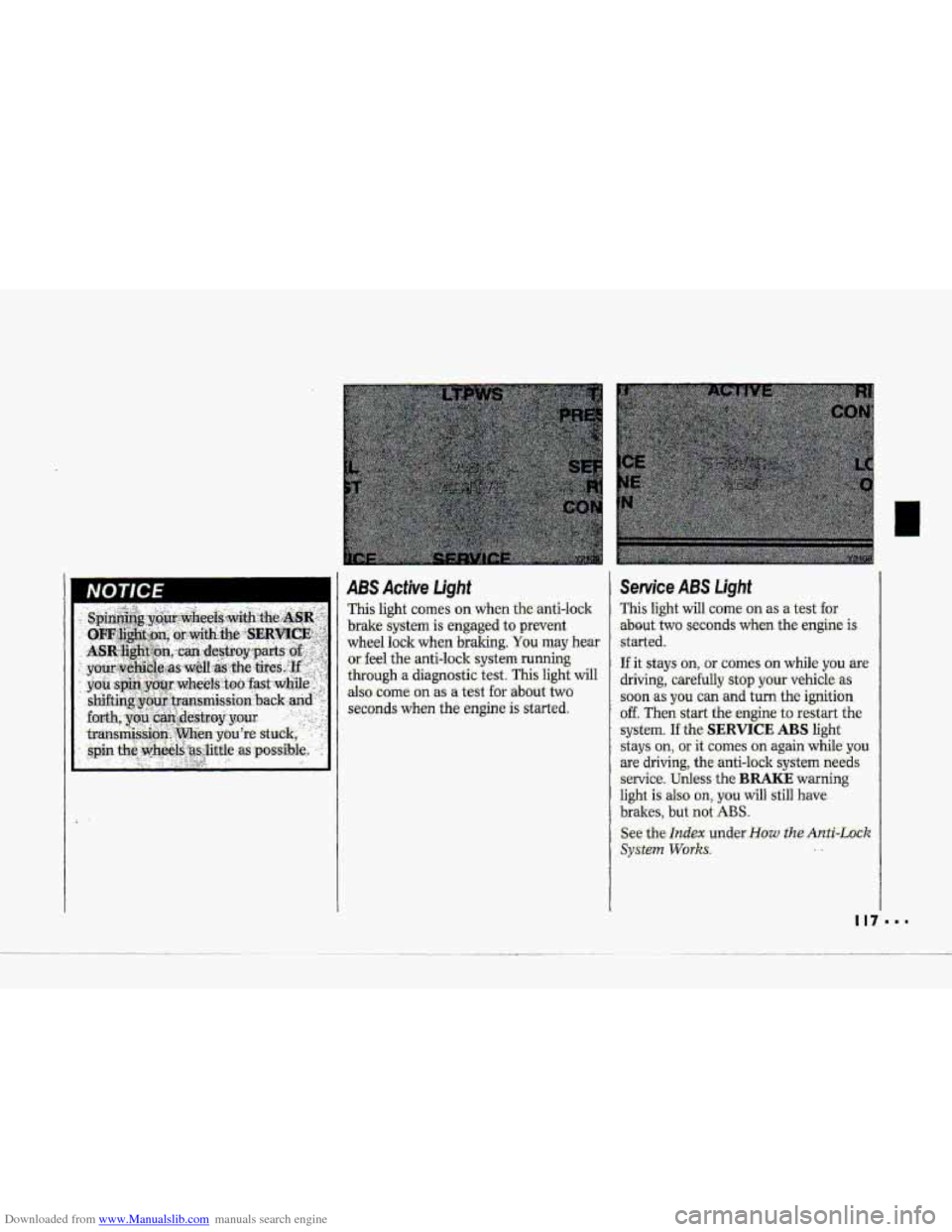
Downloaded from www.Manualslib.com manuals search engine NOTICE i I 1 ABS Active Light
This light c0me.s on when the-anti-lo-clr
brake system is engaged to prevent
wheel lock when
braking. You may hear
or. feel the-anti-lock system running
through a diagnostic test. This light will
also
come on as a test for .about two
seconds
when the engine is ‘started.
Service ABS Light
This light will come on as a test for
.about- two seconds when the engine is
.started.
If it stays on, - or comes an while you are
driving, carefully stop your vehicle as
.soon as you can and turn the ignition
off. Then start the engine to restart the
system.
If the SERVICE ABS light
stays
on, or it comes on again while you
are driving; the anti-lock system needs
service. Unless the BRAKE warning
light is also on,. you will still have
brakes, but not ABS.
See the Index under-How the Anti-Lock
SyStePn Works. ..
Page 164 of 370
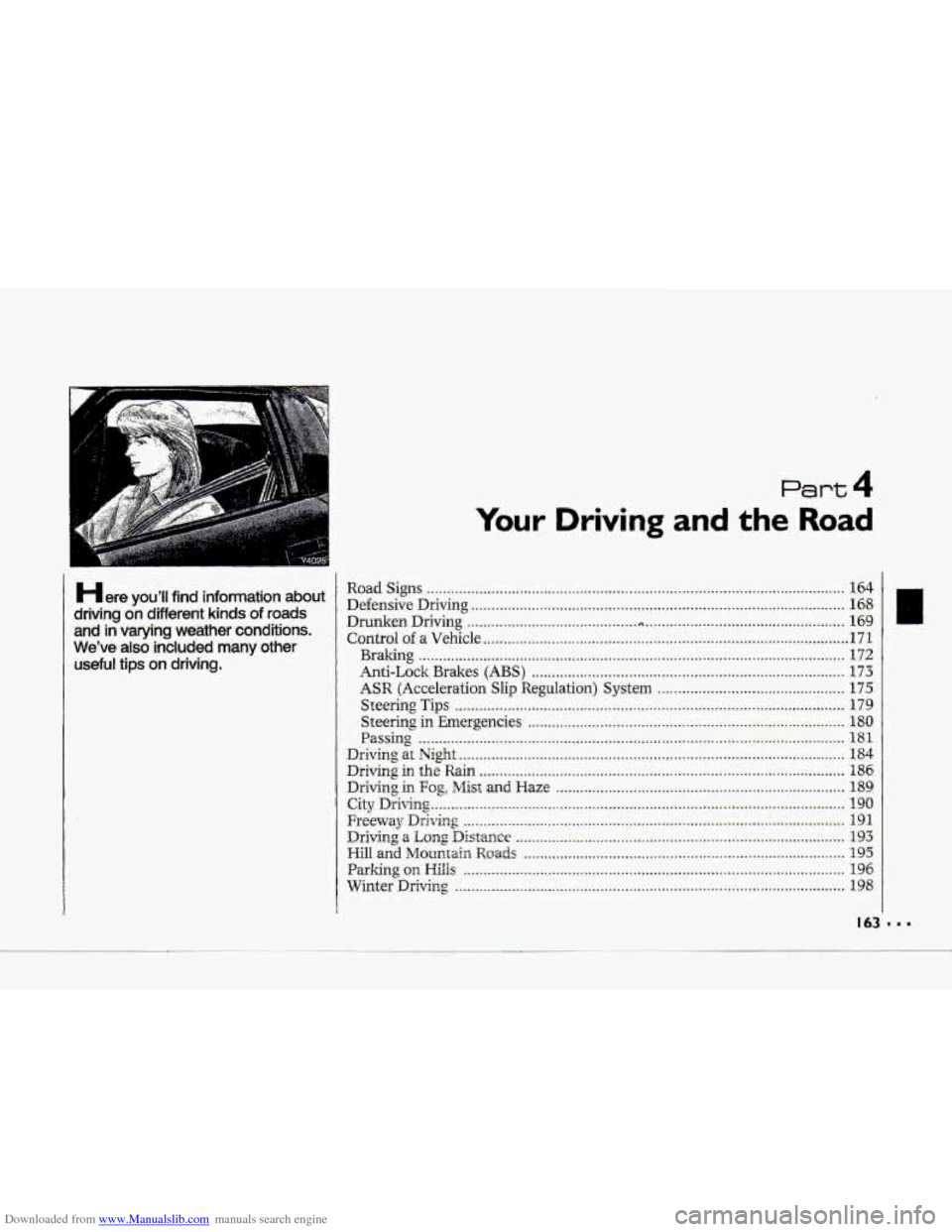
Downloaded from www.Manualslib.com manuals search engine R-
Here you'll find .information about
ddvmg on different kinds of ro.ads
and in varying weather conditions.
We've also included many other
useful tips on driving.
Part 4
Your Driving and the Road
Road Signs .. . ... . . . . .. ..... . . ,... . .. . . . .. . _. . . .. . . . . . .+. . . . . . ... . .. .. . . . . . . . . . . ... .. . . . . . . .. . . . . . . ... . .. . .... . . . . 164
Defensive Driving. . .... . . . . . . . .... . . .. . . . . &. . . . .. . ... . . . .. .. . . . . . , . . . . . . . +. . . , . , -. . . . . . . . . . . . . . . . . . . . .*. . .+ ... 168
Drunken Driving . . . . . . . . . -. . . . . . . . . . -. . . . . . . . . . . . . .I +, . , . . *. . . . . , , . . . . . . . . . , . . . . . . . . . . . . . . . . . . . ... . <.. . . . . . . . 169
Control.:of a Vehicle .. . . . . . . . . . .. . . . . . . . . . . . . . . . . . ... . . . . , . . , +. . .. . . . . . . _. . . . . . . *. . .. . . . . . . . . . . . . .. . . ... . .. . .. 17 1
Braking ........................................................................\
................................... 172
hti-Lock Brakes (ABS) ..................~.........,...........................................\
.. '.. 173
ASR (Acceleration Slip Regulation) System .............................................. 175
Steering Tips .. .. . . .. . . ... . . . . . . . . . .. . .. . . . . . . . . . . . . . . . . ._. . . . . . . . . . . . , . . ... . . . . , . . . *. . -, . , , . . . , , , , . . . ... . . , . . 179
Steering in Emergencies .... -. . . ?. . . . . , .. .. .. . . . . . . . . . . ... . . . . . . , . . . . , . . . ... . . .. .. . . . ..-. - ..... ..-. .. . . -180
Driviqp Mght ........................................................................\
......... .....,......... 184
Driving in the kin ..._....,....... .....+... +.... ......... + ................................................. 186
Driving-in Fog, Misl and Haze .... . . ._.._. . . . . . . . . . . . , . . , . . . . . . ... . . .+_. . . . . . . . . . .. . . . . . . . . . . . . . . . . . . 189
City Dnvi~i.lng _._..._.I.._._..__.___ _.___: ... ._ _.__. ............ ... . . ... .. .............. . .... . ........................ 190
-Freeway Dnvang __. . . . .. _._ ._. __. .__ . . . . -. . .. . __._ . . . . . . . . . . . . . . . ... . . . . . . -. . . . . . . . . . . . . . . . . . . . . .. . .. . .-. . ... . . 19 1
Driving a Long Distance ._ ._ _. __._ ._ _._ . . .. . . . . -. . . . . . . . . . . . . . . . . . . . . . . . -. .. . . . -.-._. . . ... . . _. . . . . . .. . . . ... . 193
Hill and hiloramai~ Rmds ........................................................................\
........ 195
Parking on Hills. I..X.1.........__.l.....I..............................................~\
...................... 196
Winter Driving __ ..._.._____... ._. ._ ._. ._. .. . ..... .. . . .. . ... . . . . . . . . . . . .... . . . . . . . . . . . , . , . . . . . . . . . . . . . .... . . . . 198
Passing *I*..* ..................................................................... -: ......... a. ..i;..i.r- .e... ;... 181 7,
2.. .
Page 173 of 370
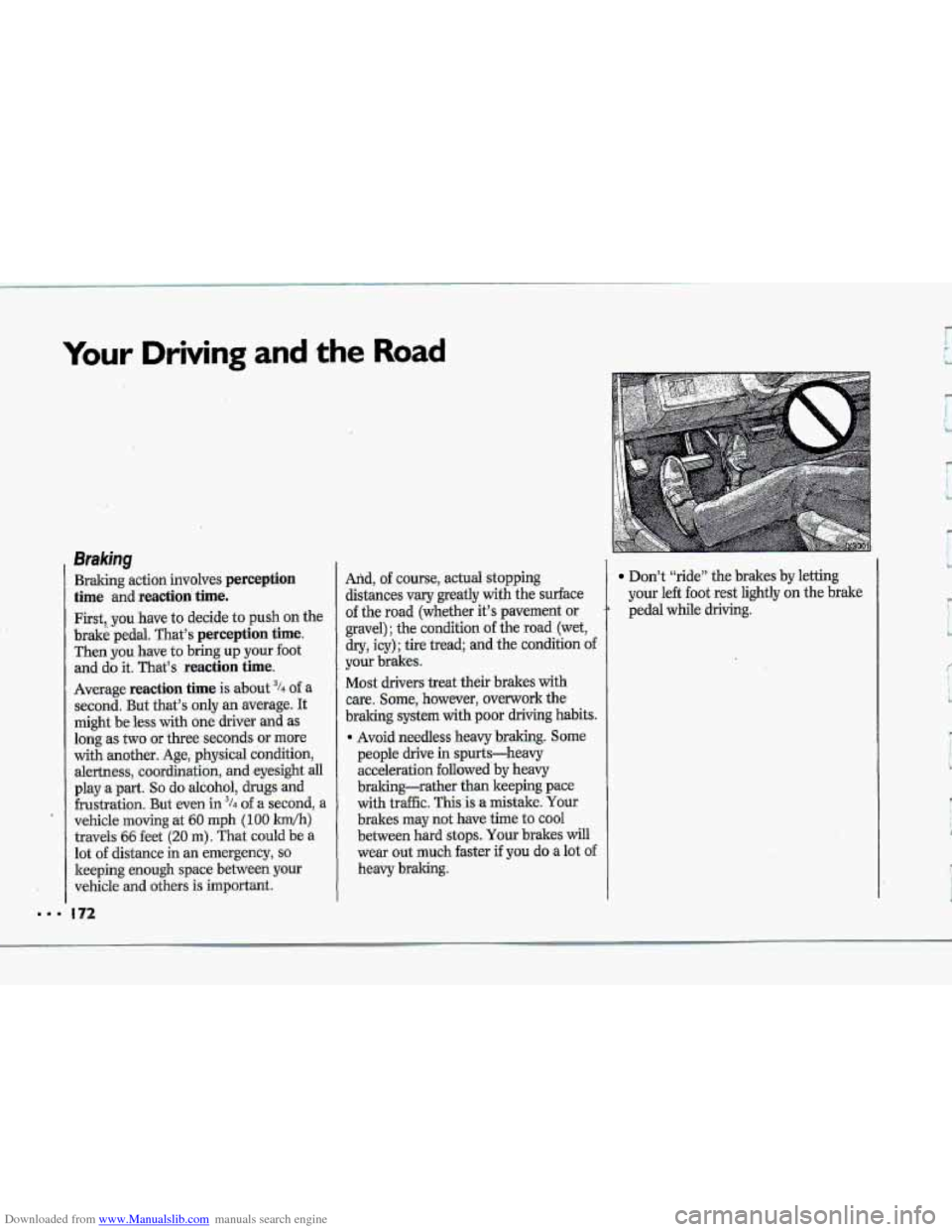
Downloaded from www.Manualslib.com manuals search engine Your Driving and the Road
Braking
Braking action involves perception
time .and reaction: time.
First, you have.to .decide to push on the
br&i pedal. That’s perception time.
Then you have to bring up your foot
and do it. That’s reaction time.
Average reaction time .is about 3/4 -of, a
second. But that’s only an average. It
might be less with one driver and- as
long as two or three seconds or mQre
with another. Age, physical condition,
alertness, coordination, and eyesight all
play a part. So do alcohol, drugs and
frustration. But even in 3/4 of a second, a
vehicle moving at
60 mph (100 Wh)
travels 66 feet (21) m). That could be a
lot
of distance in an emergency, so
keeping enough space between your
vehicle and others
is important.
And, of course, actual stopping
distances vary greatly with the surface
of the road (whether it’s pavement or
gravel) ; the conditian uf the road (wet,
dry, icy); tire tread; arid the. condition of
your brakes.
Most drivers;treat.their brakes with
care. Some, however, overwarlc the
braking system with poor driving habits.
. Avoid needless heavy braking. Some
people. drive in spurts-heavy
acceleration followed.
by heavy
braking-rather- than lreeping pace
with traffic, This.is a mistake. Your
brakes may
not have he to cool
between hard.stops. Your brakes will
wear out much faster if you do a lot of
heavy braking.
Don’t “ride” the brakes by letting
your left
foot rest lightly on the hake
pedal while driving.
I“
L
Page 174 of 370
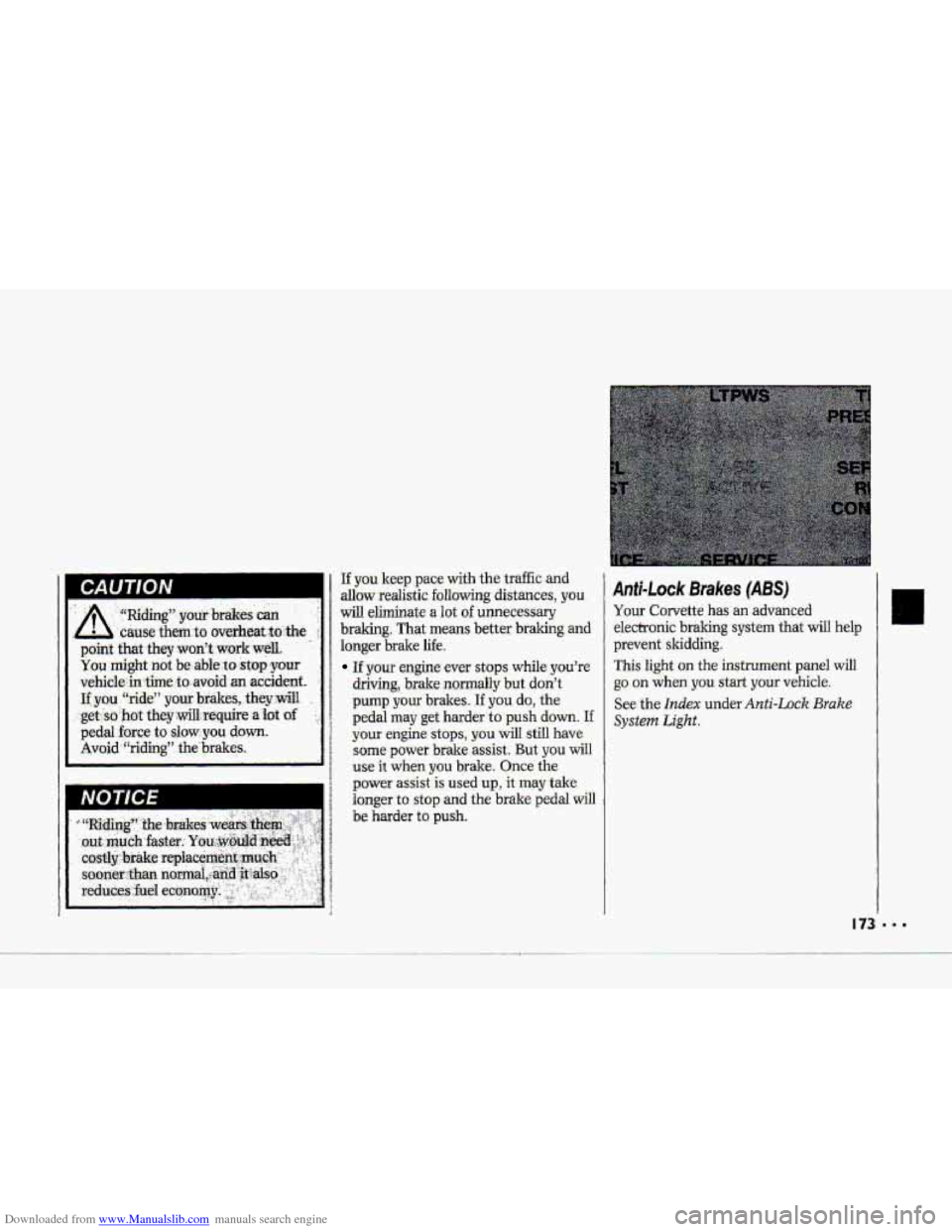
Downloaded from www.Manualslib.com manuals search engine A,,
“Riding” yom brakes. can
cause them to overheat $u:,~&e
point that they.won’t work well.
You might not be able to-stop .your
vehicle in time -to avoid an accident.
If you “ride” your bides,. they w3’i
get, suhot they :direquire a bt of
pedal force to slow you down.
Avoid “riding” the’brakes.
INoTIcE .
If you keep pace with the traffic and
allow realistic following distances, you
will eliminate a lot of unnecessary
braking. That means better braking and
longer brake
life.
If your engine ever stops while you’re
driving, brake normally but don’t
pump your brakes. If you do, the
pedal may get harder to push down. If
your engine stops, you wilI still have
some power brake assist. But you will
use it when you brake. Once the
power assist is used up, it may take
Homgez ta stop and the brake pedal will
be harder to push.
Anti-L~ck Brakes (ABS)
Your Corvette has an advanced
electronic braking system that will help
prevent skidding.
This light on the instrument panel will
go on when you start your vehicle.
See the Index under Anti-Lock Brake
System Light.
Page 175 of 370
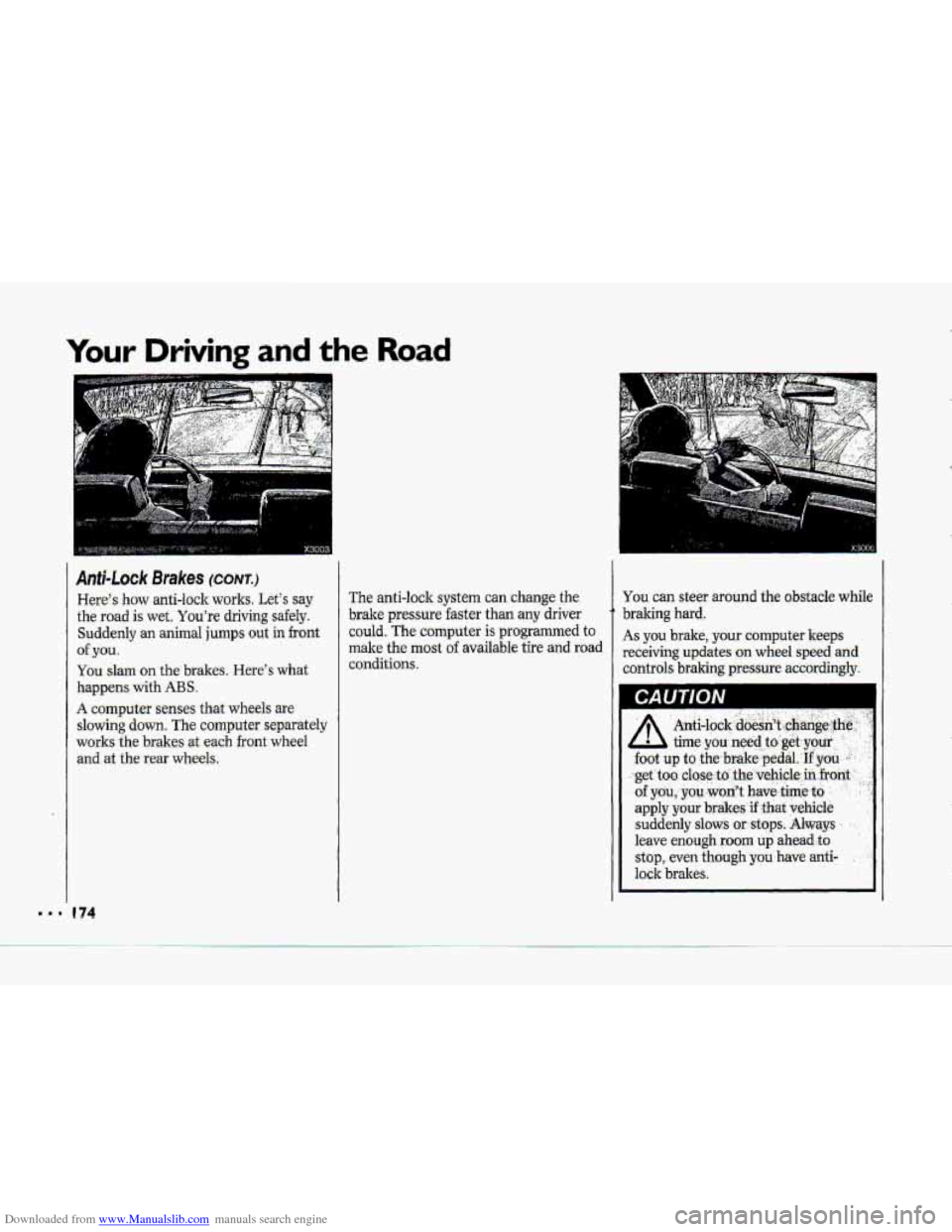
Downloaded from www.Manualslib.com manuals search engine Your Driving and the Road
L.l
Anfi-Lock Brakes (CONT.)
Here's haw anti-lock works. Let's say
the road is wet. You're driving safely.
Suddenly an animal jumps out in front
of ,you.
You slam on the brakes. ,Here's what
happens with ABS .
A computer senses that wheels are
slowing down. The computer separately
works
the brakesat each front wheel
and at the .rear wheels.
e 74
The anti-lock system can change the
brake pressure faster than
any driver
could. The computer
is programmed to
make the most of available tire alid road
conditions.
You can steer around the obstacle while
braking hard.
As you brake, your computer keeps
receiving
updates on wheel speed ad
controls braking pressure accordingly.
CAUTION
Page 176 of 370
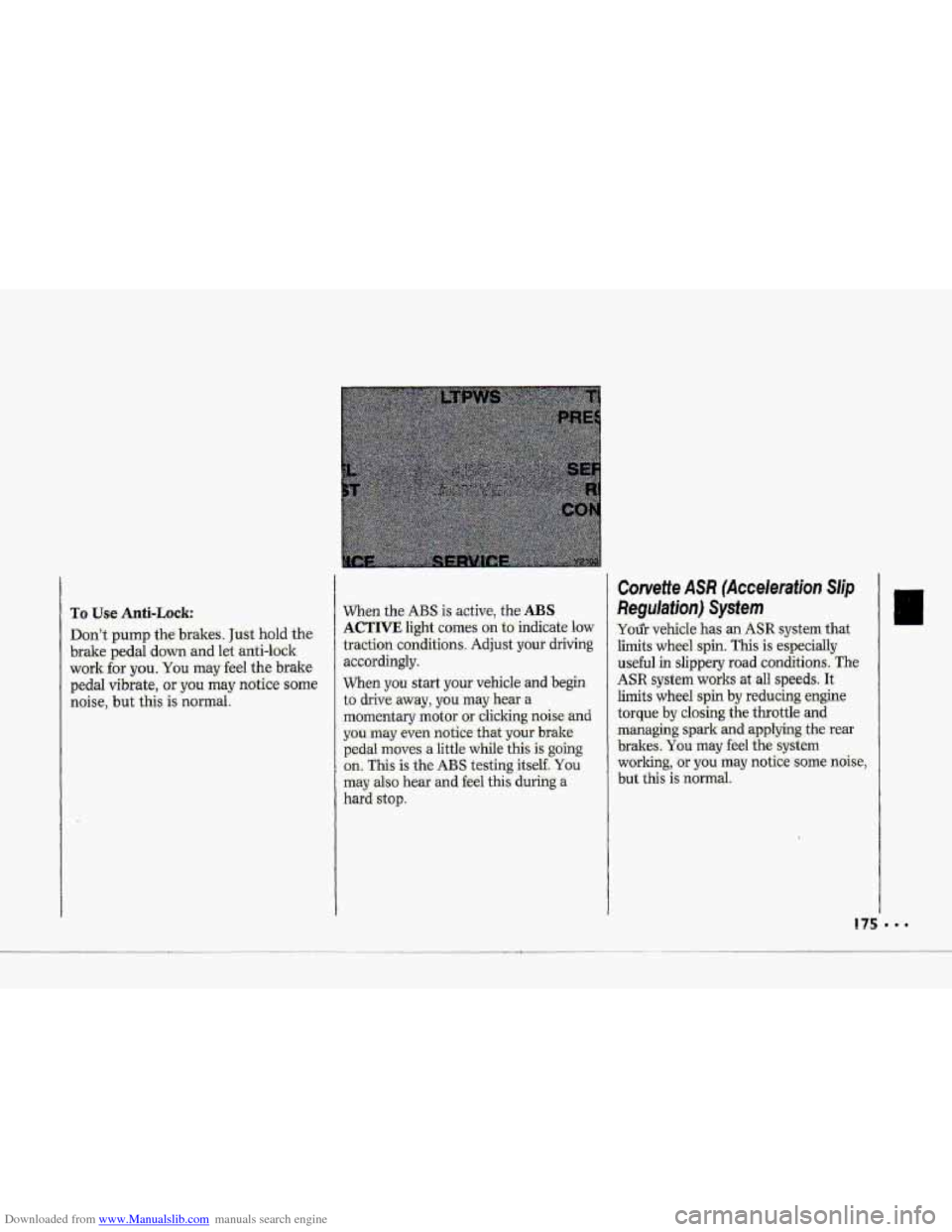
Downloaded from www.Manualslib.com manuals search engine P TO Use Anti-L.ock:
Don't pump the brakes. Just hold the
brake pedal downand let anti-lock
work for you. You may feel the brake
pedal
vibrate, or you -may notice some
noise,
but thi.s is normal.
When the ABS is active, the ABS
ACTIVE light- conies on to-indicate luw
traction conditions.
Adjust your -driving
accordingly.
When
you start your vehicle and begin
to drive away, you may hear a
momentary motsr Qr .clicking, noise-and
you. my even notice that, yow bmke
pedd -moves a little while this is going
on.
This is the ABS test-ing itself. You-
may also hear and feel this durihg a
hard stop.
Corvette ASR (Acceleration SIip
R.egulati0.n) System
Yo& vehicle has an ASR system that
limits wheel
spin. This is especially
useful in slippery road conditions. The
ASR system works at all speeds. It
limits
wheel spin by reducing englne
torque
by cLusing the throttle and
managing
sp'ark and .applyiag the rear
brakes. You may €&el the system
working., .or
you may notice some noise,
but this is normal.